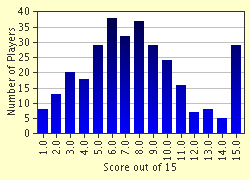Quiz Answer Key and Fun Facts
1. The central figure of Vermeer's earliest signed and dated painting is a seated woman in a gold-colored dress holding a glass of wine, which has reddened her cheeks. She is in very merry company; one man has his hand rather familiarly on her breast and is placing a coin in her open palm. She herself is smiling but seems, nonetheless, somewhat pensive.
2. There are two paintings with this title. The young woman in this painting appears heavily pregnant, stands before a map on the wall, and wears a very serious expression.
3. The subject of this painting sits in an ornately carved wooden chair and looks at the viewer. She wears a rather dull blue-grey dress (with yellow highlights), the color of which effectively contrasts with that of her principal adornment.
4. The principal feature of this painting is the expression of the richly dressed young woman as she adorns herself in the mirror.
5. This young woman opens a beautiful leaded-glass window; the sunlight which streams through illuminates her starched white headdress (rather like a nun's) and the dark but vivid blue of her skirt.
6. Like many artists of his day, Vermeer was known to use the "camera obscura" to view his subjects. The slight blurring of color and detail of objects in the foreground of this famous painting of a young girl at work may be due to this device, which sharpens focus in the background but tends to distort or blur the closer an object is. The young woman in the painting is seated and bends over her work, which clearly occupies all of her attention.
7. The young woman in this early painting sits at a table set with a bowl of fruit, a jug, and a colorful Oriental carpet. She has dark hair and a wine-red dress.
8. The second of two paintings with this title shows two women framed by a doorway, one seated and one standing. The seated one holds a lute, which she had been playing. She is richly dressed and looks up at the other with a questioning, anxious expression The other woman is handing her something and looks down at her with a knowing, sly expression.
9. A large painting of "The Last Judgement" hanging on the wall behind this woman poses an interesting juxtaposition to the activity she is engaged in.
10. This young working class girl is plainly, but colorfully dressed in a yellow blouse, a cobalt-blue apron, and red skirt. Her hair is completely covered by a plain white headpiece. The wall behind her is bare except for two baskets- one of willow and one of bright polished copper. She stands over a somewhat cluttered table.
11. There are three paintings of women engaged in this activity; in two, the subject is standing, in one she is seated. In this one, the girl stands with her back to us; we see her face only in a mirror above her head.
12. We see only the shadowy back and a bit of the rear profile of the companion to whom this young woman is listening, obviously with great enjoyment and pleasure.
13. This elegantly dressed woman sits in front of a landscape painting in an ornately carved and gilded frame. She wears a gold-colored dress trimmed in ermine and, judging by the smile on her face, clearly enjoys the activity she is engaged in.
14. Brilliantly dressed in coral and gold, this young woman looks directly at the viewer with an expression that seems to mock the two men seen with her, one fawning over her and one sulking at the table.
15. This is probably Vermeer's most recognizeable painting and has recently been the subject of a best selling book. The young woman wears a yellow and blue turban-like headdress and a yellow dress. She looks almost directly at the viewer. Unusually for a Vermeer painting, the background is completely dark and void of detail, focusing attention solely on the girl's face.
Source: Author
jouen58
This quiz was reviewed by FunTrivia editor
thejazzkickazz before going online.
Any errors found in FunTrivia content are routinely corrected through our feedback system.

